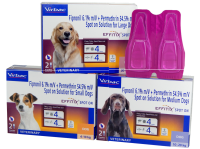
How to Clean Dog Ears: Complete Ear Care Guide
As responsible dog parents, ensuring the overall well-being of our furry companions includes regular ear care. While some dogs may naturally have clean ears, others, especially those with long ears like Basset Hounds and Cocker Spaniels, and those with a lot of fur near the ear canal like Shih Tzus, may require periodical cleaning to prevent potential ear infections. Let us discuss the importance of cleaning your dog's ears, how to determine when it is necessary, the supplies you will need, and a step-by-step guide on how to clean your dog's ears.
Why Cleaning Your Dog's Ears Matters
A dog's ear health is a crucial aspect of their overall care routine. Regular cleaning helps prevent the buildup of dirt, debris, and moisture in the ear canal, reducing the risk of infections. Unlike our horizontal ear canals, our pets have L-shaped ear canals. This makes them quite prone to ear irritations and infections, as moisture and debris can get built up and trapped in the horizontal portion of the L. Furthermore, with floppy-eared dogs and dogs with lots of hair in the ears, ventilation of the ear canal to keep it dry is impeded. It is essential to observe your dog's behaviour and physical cues to determine when their ears need attention.
How to Tell When a Dog’s Ears Need Cleaning
If your pet has floppy ears or has a lot of fur in and around the ear area or tends to suffer often from ear infections, your vet may often advise a more regular ear cleaning routine such as once in 15 days to once a month. Preferably clean the ears after a bath, this helps to also get rid of any trapped water that may trigger an infection. If you observe signs such as a foul odour from the ears, excessive ear scratching, excessive head shaking or ear tilting, redness and swelling, strongly indicates the onset of an ear infection and hence the need for vet intervention.
Ear-Cleaning Supplies
To clean a dog's ears effectively and safely, gather a few essential supplies: a cotton ball or gauze and a veterinary-approved ear-cleaning solution. Avoid using cotton-tipped swabs or pointed tools, as they can cause harm to the ear canal. Additionally, choose a convenient location for cleaning such as your bathroom, as it can be a messy process.
Choosing the Right Dog Ear-Cleaning Solution
While homemade solutions exist, it is safest to use veterinary-recommended ear-cleaning solutions. Some homemade options may contain harmful ingredients or prove ineffective. Consult your veterinarian for recommendations tailored to your dog's specific needs. Never self-medicate or self-decide!
How to Clean Dog Ears in Three Easy Steps
Begin by preparing and calming your dog. Assemble all the necessary supplies within reach, ensuring you have a cotton ball or gauze and a veterinary-approved ear-cleaning solution It is crucial to choose a calm time for the ear-cleaning session, and using treats can help create a positive association for your pet.
Moving on to the application of the ear-cleaning solution, gently squeeze the solution into your dog's ear canal. Fill the ear canal with the ear-cleaning solution. Take care to avoid contaminating the solution by ensuring the applicator does not touch the ear. Massage the base of the ear for about 30 seconds, allowing the solution to work in dislodging and dissolving any debris or buildup within the ear.
After applying the solution, allow your dog to shake their head. This natural reaction helps dislodge any loosened debris from the ear. Use a towel to protect yourself from any splashes.
The final step involves gently wiping the outside of the ear with a cotton ball or gauze. Ensure you do not push the cotton ball or gauze into the ear canal. If, at any point during the process, your dog appears to be in pain or discomfort, it's crucial to stop and consult your veterinarian.
Tips for Keeping Your Dog Calm During Ear Cleaning
Training and patience play key roles in helping your dog stay calm during ear cleaning. Start young – get your young pup comfortable with its ears being touched and lifted. If you have started this ear cleaning routine during the later stages of life, then it is important to gradually introduce the process by petting, touching, and lifting their ears. Use positive reinforcement and treats to associate ear cleaning with a positive experience. If your dog appears uncomfortable or in pain, consult your veterinarian.
Conclusion
Regular ear cleaning is an important aspect of maintaining your dog's overall health. By following these simple steps and being attentive to your dog's cues, you can ensure a positive and effective ear-cleaning routine. Prioritize your dog's comfort and well-being, and consult your veterinarian if you notice any signs of ear issues that may require medical attention. With proper care, you can keep your furry friend's ears clean and healthy for a lifetime of happiness.

 Sen.jpg)
.png)

